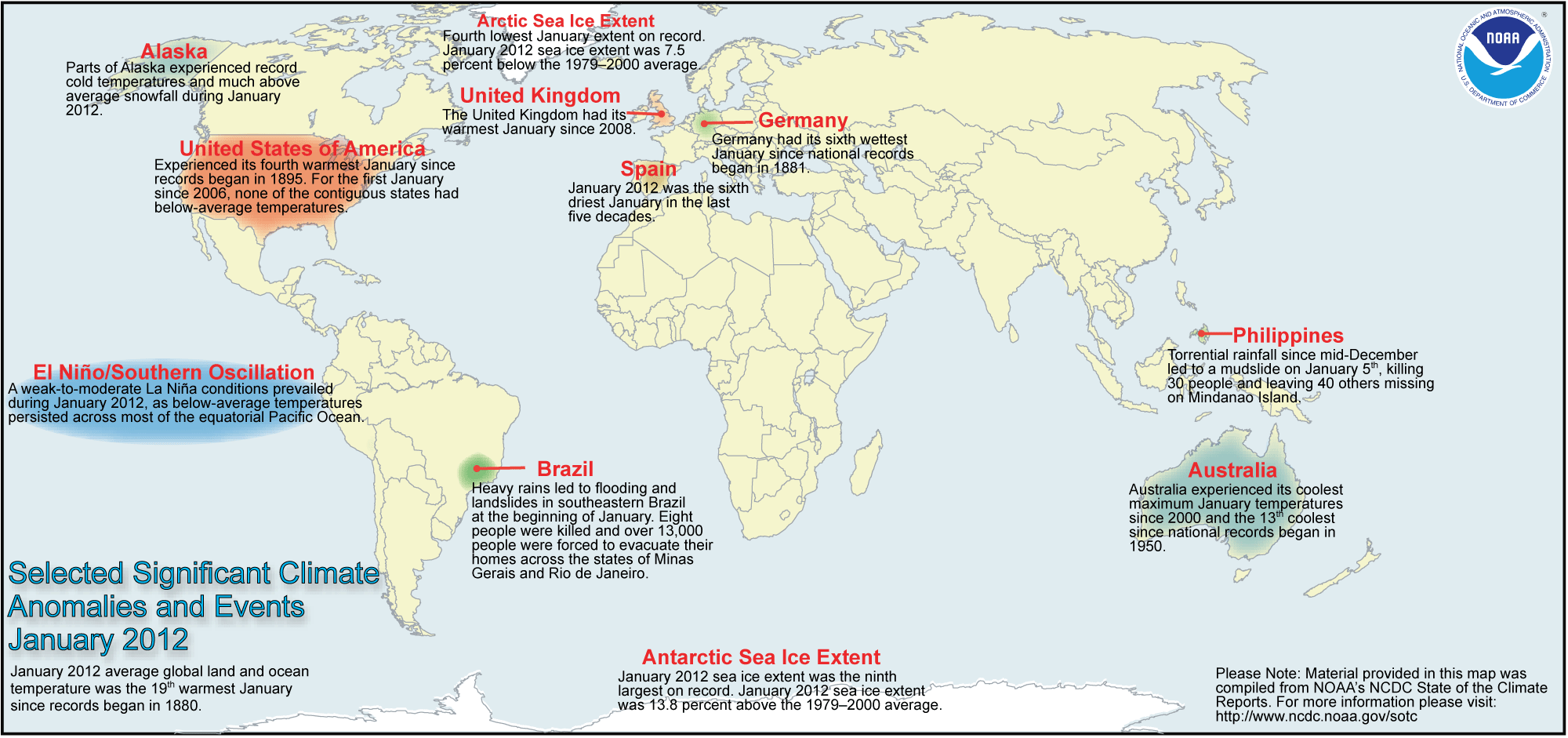Monthly Report Summary Information
The Monthly Report Summary Information is a synopsis of the collection of national and global summaries released each month.
Global Summary Information - January 2012
See Full Report
Note: Due to a processing error, the January 2012 Global report originally reported incorrect temperature anomalies for the land-surface components for the globe and each hemisphere. These caused the combined land and ocean surface temperatures to be incorrect as well. This error did not affect the historical rank for the January combined land and ocean temperature, which remains 19th warmest. However, it did affect the rank of the land-only component. With the corrected data, the land only component is now the 28th warmest on record (rather than 26th warmest, as originally reported). The corrected data are reflected in this report as of 17 February 2012. We regret the error and any issues it may have raised for users.
Global temperatures 19th warmest on record for January
The globe experienced its 19th warmest January since record keeping began in 1880. Arctic sea ice extent was the fourth smallest extent on record for January at 7.5 percent below average. Additionally, La Niña conditions continued during January 2012. According to NOAA's Climate Prediction Center, La Niña is expected to dissipate during the Northern Hemisphere spring.
January 2012 marks the coolest month since February 2008. However, January 2012 also marks the 26th January and 323rd consecutive month with a global temperature above the 20th century average. The last month with below average temperatures was February 1985.
Global temperature highlights: January
- The combined global land and ocean average surface temperature for January 2012 was the 19th warmest on record at 54.23°F (12.35°C), which is 0.63°F (0.35°C) above the 20th century average of 53.6°F (12.0°C). The margin of error associated with this temperature is +/- 0.14°F (0.08°C).
- Separately, the global land surface temperature was 0.88°F (0.49°C) above the 20th century average of 37.0°F (2.8°C), making this the 28th warmest January on record. The margin of error is +/- 0.31°F (0.17°C). Warmer-than-average conditions occurred across most of North America, the northern latitudes of Europe and Asia, southern South America, and most of Australia. Cooler-than-average regions included China, Mongolia, Kazakhstan, south central Russia, much of the Middle East, northern India, north Africa, and southwestern Greenland.
- The Arctic Oscillation climate pattern played a role in temperatures in the Northern Hemisphere during January. The positive phase during the first half of the month contributed to well-below average monthly temperatures across Alaska and above-average temperatures across the contiguous United States. The negative phase during the second half of the month contributed to warmth in Canada and also to a cold snap that began during the last week in January across Central and Eastern Europe and north Africa.
- The January global ocean surface temperature was 0.54°F (0.30°C) above the 20th century average of 60.5°F (15.8°C), making it the 17th warmest January on record and coolest monthly ocean temperature since January 2008. The margin of error is +/- 0.07°F (0.04°C). The warmth was most pronounced across the north central and southwestern Atlantic Ocean, the central and western Pacific, and the southeastern Indian Ocean.
Polar Sea Ice and Precipitation Highlights
- The growth rate for Arctic sea ice in January was the slowest in the satellite record. The average sea ice extent for the month was 7.5 percent below average, ranking as the fourth smallest January extent since satellite records began in 1979. The extent was 425,000 square miles (1.1 million square kilometers) below average. This marks the 19th consecutive January and 128th consecutive month with below-average Arctic sea ice extent.
- On the opposite pole, Antarctic sea ice during January was 13.8 percent above average, and the seventh largest sea ice extent on record for the Southern Hemisphere since records began in 1979.
- Northern Hemisphere snow cover extent during January was slightly above average, with large differences between the North American and Eurasian land areas. Eurasia had its ninth largest snow cover extent in the 46-year period of record, where cold and snowy conditions dominated across central and Eastern Europe, as well as much of China. North America had its third smallest January snow cover extent, where much of the United States and southern Canada were warmer and drier than average, limiting snow cover.
- Monsoonal rains brought heavier-than-average rainfall to southwestern and southeastern Australia. Precipitation was also much above average in south Asia, part of eastern Russia, and southwestern Greenland. Much drier-than-average conditions were observed across northern Canada, the north central United States, eastern Brazil, and northern Sweden.
 NOAA's National Centers for Environmental Information
NOAA's National Centers for Environmental Information

